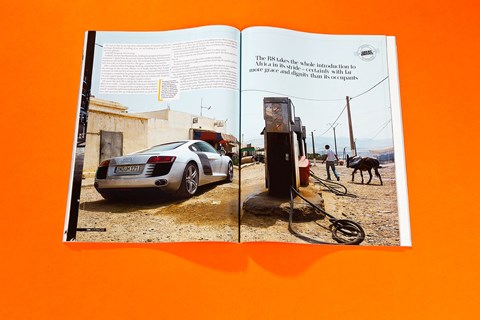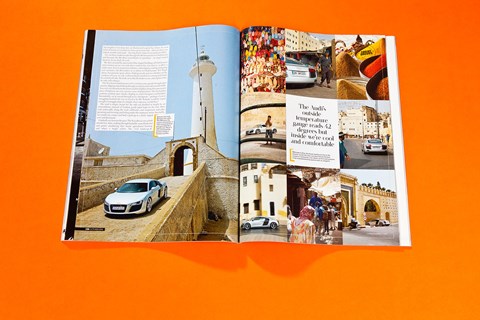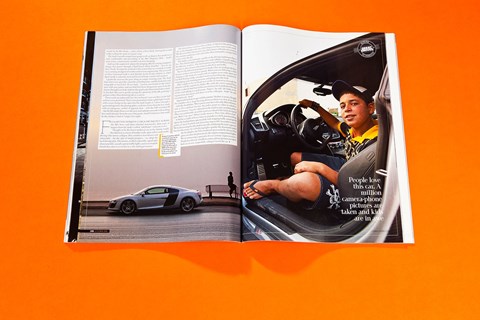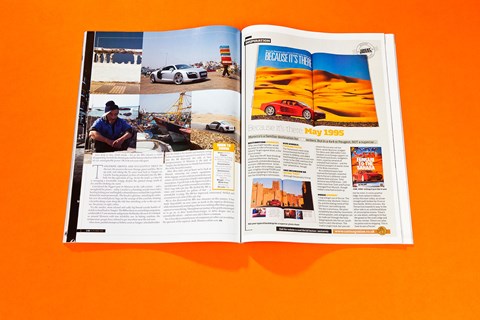► In 1995 we took a Ferrari to the Sahara
► In 2008 we were desert-bound again, in an R8
► Into Africa in Germany’s most surprising supercar
Because it’s still there – CAR magazine took on the Sahara in a Ferrari back in 1995, ‘because it was there’. Today we’re back on the road to Morocco in Audi’s supercar, the superb R8.
We’ve been in Morocco barely five minutes when a dodgy-looking customs ‘official’ takes off with the registration document for the Audi R8. Oh, and my passport. He vanishes into the shadows of Tangier’s steaming, stinking port and the policeman with a small whistle and big gun is absolutely not interested – at least that’s how I interpret his smirk and shrug. It’s 2am, we’re tired and Africa, it seems, is saying a big ‘hello’ and an even bigger ‘f**k off’ to CAR on its return to Morocco. Oh dear. This is not going well.
Rewind 1800 miles and 36 hours, and photographer Jason Furnari and I are taking delivery of an Audi R8 (every option ticked) at Munich airport, and stuffing camera gear, iPods, luggage, sat-navs and sun cream into every crevice and pocket of Audi’s mid-engined masterpiece.
Then comes the ritual of zeroing the trip meter – a wonderful moment before any long journey – but this time it takes on special significance. We’re heading for Morocco – scene of some of CAR magazine’s most legendary journeys – and we’re driving there in our current favourite supercar. We know the Audi can do track, and A-road and B-road and motorway, but can it do north-east Africa? There will be no sterner test for this magnificent car. Rough calculation suggests the R8 will need to impress over seven days, 4500 miles, five countries and two continents. Germany, Austria, Switzerland, France, Spain. The R8 takes us across Europe swiftly and comfortably. Ahead of us, Africa draws us like a moth to a light.

We stop once in 1800 miles, at a motel near Valencia airport, but no sooner do we close our puffy eyes than we’re opening them again to continue our trek. At half-past midnight we board the ferry at Algeciras, near Gibraltar. We’re deliriously tired but Furnari and I can’t sleep. We talk about Morocco, the medinas and the richly metamorphosing landscape.
Imagine it: William Burroughs, Jack Kerouac, Truman Capote, Ronnie Kray, Oscar Wilde, Mick Jagger and Errol Flynn all stood on the deck of the ferry from Algeciras to Tangier comparing stories of casual hedonism and debauchery within the city’s maze of streets. All visited Tangier; all (we presume) had a lot of fun here.
For centuries, Tangier was not only considered one of the most exotic resorts on the Mediterranean but also a writhing hive of drugs, boys, girls… and disinterested policing. You can have anything you want in Tangier, as long as you have the money, or so the saying goes.
Much to the frustration of the Moroccan government, scores continue to flood into the country expecting to experience some kind of beatnik pilgrimage of cheap sex, cheaper hashish and zero consequences. And there’s a more sinister undercurrent: Tangier has become a waypoint for people-smuggling. We roll the R8 off the ferry with a dry, anxious taste in our throats and I suddenly have a new best friend who makes off with my passport and registration document. We don’t want to queue, he tells (not asks) us. He will get our papers stamped and we can leave customs immediately. Then he wanders off.
An hour later and we’re in the same queue, the two most valuable items on my person (bar my wedding ring) have disappeared into the seedy belly of Tangier’s sprawling port and I feel like hitting the policeman smirking at my dilemma. That wouldn’t help – the local jails are considered some of the most frighteningly squalid in the world. We wait in our big silver advertisement of western wealth and privilege. Everybody is looking at us, yet not looking at us, with sinister sideways glances. And still the queue isn’t moving. Suddenly, my new best friend returns, holding my passport and registration document. I sprint from the car and retrieve them feeling simultaneously murderous and embarrassingly naive. He surrenders the documents then tells (not asks) us to hand over €10. We agree.
After a domino effect of beeping, howling, screaming hooters that gets the message to the customs officers, we’re finally moving. And Tangier welcomes us with our first of many near-misses; a battered Ford attempts to navigate a roundabout by going through us. Such is my wired delirium, I’m sure I spot Capote, Wilde, Jagger and Flynn in a shisha café, laughing at our fumbling attempts to navigate Tangier’s streets.
Of course the Audi R8 is taking the whole introduction to Africa in its stride – certainly with far more grace and dignity than its occupants. It navigated the steep ferry ramp without a crunch, steered the tight inner parking deck of the ferry without fuss, and squeezed into an underground hotel car park with nothing but a comforting chirrup from the parking sensors. What’s happening, we realise as we flow out of Tangier the next morning towards the Rif mountains, is that the R8 is forcing us to redefine the ‘term’ supercar. In the supercar dictionary, ‘usability’ is a dirty word. To reverse a supercar you should first need to open the door and sit on the sill. To service a supercar you need the wealth of a Sheikh. To drive a supercar in traffic you need the clutch-leg of a gorilla and the patience of an angel. Lethal on-the-limit handling is a ‘carakderistic’ of a supercar, as is a gearbox that refuses to select first until the transmission fluids are warm.

The Audi blows a big four-ringed raspberry at these supercar conventions. It unites the glorious aesthetic theatre of the supercar (low, wide, lovely) with genuine – here comes that dirty word – usability. The R8 grants the driver quicker access to the car’s genuine supercar credentials. And boy, what credentials. The engine, so-un-Audi, sings and roars and sucks big lungfuls of air deep into an illuminated engine bay where, by some kind of fission, it’s turned into forward motion and – often on these sun-baked roads – four big black strips of caramelised rubber. Yes, on the roads through the Rif mountains to Chefchaouen and beyond, the R8 often overwhelms its guardian – an angel named Quattro. So un-Audi. So cool.
We skirt around the spectacular blue-tinged buildings of Chefchaouen and continue on our 200-mile drive south to Fes. For what is, in effect, a trade route, host to numerous cultures, and religions coming and going over centuries, the R8 renders us as aliens in Chefchaouen. Not illegal aliens, but genuine space-aliens. Parking neatly next to a donkey on the outskirts of town, we ask a tobacco dealer nestled in a corrugated shack for a bottle of Coke. He looks at us like the berks we are, and explains that he only sells tobacco
The N13 from Chefchaouen to Fez via Ouezzane speeds through open country, dipping and climbing through scorched earth and cannabis fields. You can’t see them from the main road but hidden along this spectacular piece of highway are over 200,000 acres of plantations. The local police perform random spot checks, hoping to catch foreigners red-handed.
Remarkably, we’re waved through every checkpoint – perhaps if you’re smuggling hashish the way to travel is by R8. Nobody would be stupid enough to smuggle dope in a bright silver supercar, would they?
The road is empty except for the odd van doubled in height by an extraordinary amount of random goods piled high on the roof. Most
crab awkwardly along the road, subframes, suspension and axles groaning and twisting and failing under the immense strain. Inevitably, we round one corner and find a pick-up in a ditch, tipped over and destroyed.
Gradually we increase the pace. The N13 takes us on a climb into the low-Atlas, snaking through hayfields, some blackened and gently smoldering after recent agricultural burning and others a bright yellow. The vivid landscape streaks by the R8’s flanks – yellow, black, yellow, black. Driving these roads is like surfing the spine of a giant wasp.
The Audi’s outside temperature gauge reads 42 degrees but inside we’re cool, and marvelling at the R8’s Magnetic Ride – Audi’s semi-active, continuously variable real-time damping. Audi says the suspension ‘adjusts the damping effect by varying a magnetic charge that passes through a fluid-based shock absorber’ – but we say it works via a cunning amalgam of voodoo and reverse engineering. The net result is near-Bentley levels of ride comfort or, when Sport mode is selected, increased levels of body control and tautness.

I gradually increase the pace along an empty, twisting road. The Audi bites into every apex like a piranha at feeding time, and the hydraulic rack telegraphs so much feel. So un-Audi… Loosen your hands on the wheel, steer with your palms and you find that fewer frequencies pass from the chassis through your body and into the quick rack (three turns lock-to-lock). It also feels like you’re gently teasing the speed out of the R8; painting a picture rather than throwing ink at a canvas.
These roads are indecently fast, but we haven’t seen another car for half an hour so we push hard. There’s one particularly tricky uphill right-hander with a nasty bump on the apex that the Audi laughs at. I drive
through it again and again for the photographer, each time faster than the last, ready with an emergency armful of opposite lock – with the ESP switched off – but the R8 simply floats over the crest and explodes onwards with nothing but a mild shimmy from the seat of my pants. And if I’m honest, that could be the chicken I had in Tangier last night.
Flea-bitten donkeys lurch drunkenly across the R8’s bows and three-wheeled motorcycles skim coats of lacquer from the Audi’s carbon ‘sideblades’: welcome to Fez. Thought to be the finest medieval city in the Islamic world, the old town is a maze of market stalls, spice sellers and terrible driving. Our nerves collapse after countless near-misses and reluctantly – for the sake of simple progress – we adopt the local driving style. This means signal right (then turn left), casually ignore traffic lights, and swat mopeds should they attempt to overtake safely or legally.
The labyrinthine medina of Fes el Bali, a UNESCO World Heritage site, is also one of the largest car-free zones in the world. We discover this only after three hours of fruitlessly scouring the ancient sandstone walls and arches that surround it, trying to find a way in for the R8.
The Audi is astonishingly capable in this driving nightmare. The clutch is light and progressive, visibility is superb and the clutch-preserving hill-holding facility (an option) is a major advantage in this heat and traffic. But it’s the deliciously progressive brakes that are the best feature at these sub-tortoise speeds. When you are following a child clinging to the back of a coach with its engine cover wide open and fan-belt flailing wildly, you don’t want to exacerbate the situation by misjudging your braking pressure and piling into the back.
After a night in Fez we head west on the A2 motorway towards the Atlantic and the capital city, Rabat. We settle the cruise control bang on the 120km/h limit but within ten minutes we’re parked at the side of the road talking to a policeman. ‘Papers,’ he asks. He looks at the registration document and shows it to his colleague. ‘Audi?’ he asks incredulously. ‘Audi?’
Apparently he had a wager with his partner. Neither, it seems, thought the complex silver shape bearing down on them was that of an Audi – and why should they? We’re pretty sure this is the only R8 in Morocco and, as if to celebrate the fact, the police grant us 10km in which to ‘go very fassssst’. Exactly 10km down the road we pass another police officer sat comfortably on a little stool, eyes fixed to the back of a speed gun. Well, I say ‘pass’. What I really mean is ‘blow him off his stool’.
In Rabat a couple of hours later we partake of a little promenading. Again, the Audi performs spectacularly well, stopping traffic, interrupting games of street football and attracting impossibly beautiful women. We’re discovering that the Audi is not only redefining the term ‘supercar’ but also the exotic. Its LED driving lights sparkle like diamonds under the headlights; the V8 is rendered spectacular by the ice-blue glow cast onto the plenums by the engine compartment lights. We’re witnessing a spectacle of 21st century supercar excess. People love this car. Camera-phones click. Kids are in awe. Jaws drop as they climb inside – for us the R8’s interior is mildly disappointing. For kids the chrome gate and flat-bottom wheel are indications of vast, unimaginable power. Oh to be ten years old again.
Tangerine groves and eucalyptus trees to the east, the ocean to the west. Orange, green and blue. We’re up early and taking the N1 coast road back to Tangier via Larache having pumped 59 litres of unleaded into the R8’s belly for the equivalent of £45. So far the Audi’s 4.2-litre V8 is averaging a reasonable 21mpg, despite the spirited charge north of Fez and the choking city crawl.
Considered the biggest port in Morocco in the 15th century – and a stronghold for pirates – today Larache is a charming seaside town with a bustling fishing port and brightly coloured houses stacked like Lego bricks behind the main promenade. The beach is glorious, stretching for miles, but now discarded plastic bags are the scourge of this coastline, forming a heartbreaking scum along the tide line. No pirates in sight, either.
Via the smaller, more relaxed and sadly fog-bound seaside hamlet of Asilah we head back to Tangier. The R8 has been an astonishing companion; comfortable GT one moment and genuine thrillmaker the next. It’s whisked us around Morocco with true reliability too. In baking sunshine, the temperature gauges have refused to get anywhere near the red zone.
Once more, painful attempts at bribery await at Tangier. A fat dockworker demands €10 – for food, he says. I sink into the R8 depressed, not only at how unrepresentative of Morocco is the port of Tangier, but also because we shortly have to leave this richly beautiful country.
After 1800 miles and 36 hours we’re back in Munich, extracting our gear from the R8. In total we’ve covered 4542 miles in seven days, or 649 miles per day. We fuelled the R8 15 times and consumed 201 gallons of fuel – a remarkable 22.5mpg. The R8 has impressed, entertained, thrilled and cosseted on every mile. We’ve also discovered the R8’s true character on this journey. It has made ‘dependable’ an asset (once an insult in the supercar dictionary) while simultaneously reminding us that it was nothing other than a genuine supercar we were driving. Throughout our journey it has gently encouraged us to go on, to drive harder/faster/longer, to delve deeper into its considerable talents. And not once did it throw a tantrum.
Yes, it has taken a manufacturer of competent yet sober cars to redefine the spectacle of the supercar. Audi, Morocco salutes you.
